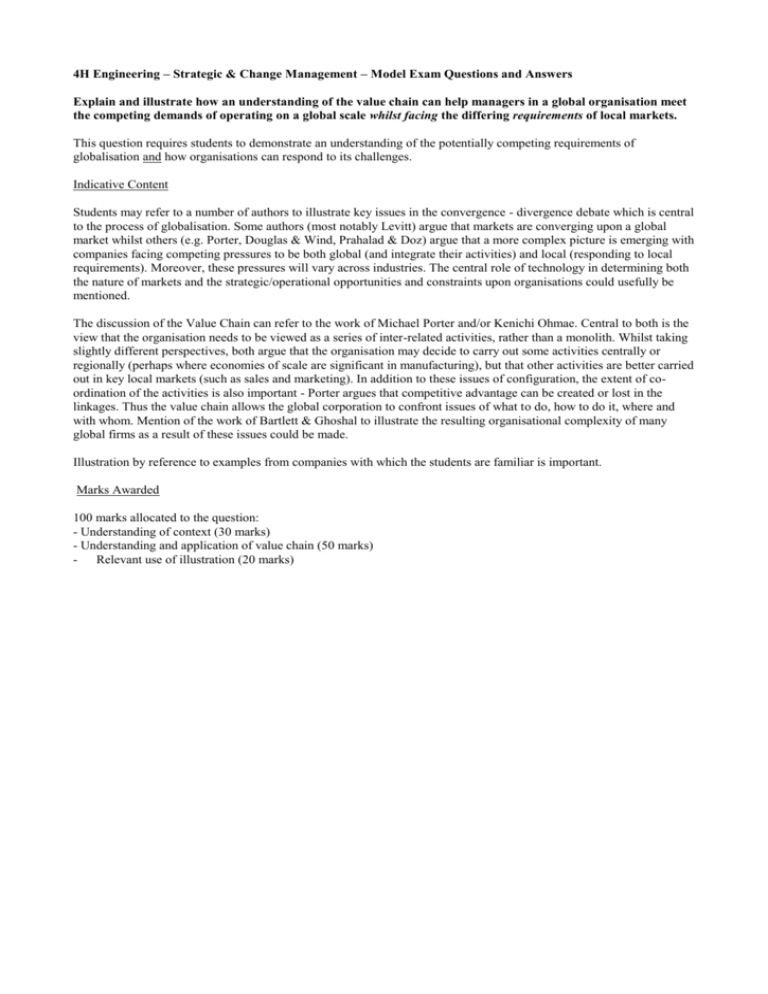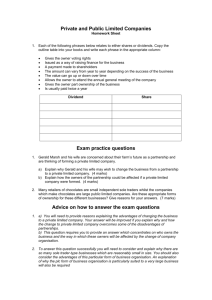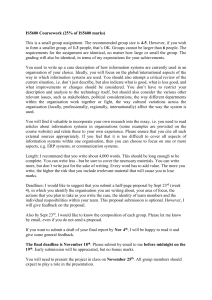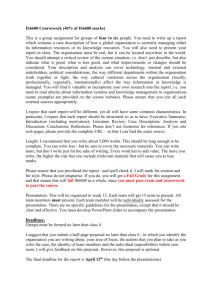Explain and illustrate how an understanding of the value chain can
advertisement

4H Engineering – Strategic & Change Management – Model Exam Questions and Answers Explain and illustrate how an understanding of the value chain can help managers in a global organisation meet the competing demands of operating on a global scale whilst facing the differing requirements of local markets. This question requires students to demonstrate an understanding of the potentially competing requirements of globalisation and how organisations can respond to its challenges. Indicative Content Students may refer to a number of authors to illustrate key issues in the convergence - divergence debate which is central to the process of globalisation. Some authors (most notably Levitt) argue that markets are converging upon a global market whilst others (e.g. Porter, Douglas & Wind, Prahalad & Doz) argue that a more complex picture is emerging with companies facing competing pressures to be both global (and integrate their activities) and local (responding to local requirements). Moreover, these pressures will vary across industries. The central role of technology in determining both the nature of markets and the strategic/operational opportunities and constraints upon organisations could usefully be mentioned. The discussion of the Value Chain can refer to the work of Michael Porter and/or Kenichi Ohmae. Central to both is the view that the organisation needs to be viewed as a series of inter-related activities, rather than a monolith. Whilst taking slightly different perspectives, both argue that the organisation may decide to carry out some activities centrally or regionally (perhaps where economies of scale are significant in manufacturing), but that other activities are better carried out in key local markets (such as sales and marketing). In addition to these issues of configuration, the extent of coordination of the activities is also important - Porter argues that competitive advantage can be created or lost in the linkages. Thus the value chain allows the global corporation to confront issues of what to do, how to do it, where and with whom. Mention of the work of Bartlett & Ghoshal to illustrate the resulting organisational complexity of many global firms as a result of these issues could be made. Illustration by reference to examples from companies with which the students are familiar is important. Marks Awarded 100 marks allocated to the question: - Understanding of context (30 marks) - Understanding and application of value chain (50 marks) - Relevant use of illustration (20 marks) Taking an organisation with which you are familiar, outline and critically assess how the tools and frameworks of Michael Porter’s Positioning Approach can help shape its strategy. This question requires students to demonstrate the application of the tools and frameworks of the Positioning Approach to a selected organisation. A critical assessment of the approach needs to be made, either by outlining the points of difference with other approaches (e.g. resource based approaches) or by outlining the critiques made of positioning, and generic strategies in particular. Indicative Content Some discussion of the overall approach is desirable - an “outside - in” approach, which attempts to understand the external environment and position the organisation within the environment so as to defend itself from, or to exploit, the competitive dynamics. The three main tools/frameworks should be outlined - Five Force Framework; Value Chain and Generic Strategies. The purpose and inter-relationships between the tools/frameworks also need to be outlined and demonstrated. The student needs to show how the tools/frameworks are applied within the overall approach. Critical to the answer is the application of the tools/frameworks to a particular company. Demonstration of the application needs to be clear (use of organisationally specific diagrams would be one way). In addition, a clear logic between the tools/frameworks needs to be shown - does the strategy address the implications of the competitive forces analysis; how will the value chain be configured to meet the demands of the strategy etc.. Awareness of the debate over generic strategies and/or the differences of positioning with resource-based approaches needs to be discussed. Marks Awarded 100 marks allocated to the question: - Understanding of overall approach and individual tools/frameworks (30 marks) - Application of tools/frameworks to specific example (50 marks) - Critical assessment of the approach (20 marks) In what ways might an organisation’s approach to managing complexity affect the view it takes of acquisitions and mergers as a key component of corporate strategy. Illustrate your answer with examples drawn from organisations with which you are familiar. A discussion of one of the key aspects of corporate level strategy (the approach to managing complexity) and how this might affect an organisation’s view of a major method of corporate development (mergers and acquisitions). The work of Goold, Campbell and Luchs on management styles and/or an outline of Portfolio, Linkages and Core Competences approaches are central to the question. Indicative Content Students need to provide an outline of either Goold, Campbell and (latterly) Luchs work on management styles - the three stereotypes of Financial Control, Strategic Control and Strategic Planning and how these are delineated. The key parameters of the extent and nature of planning influence and control influence should be mentioned. Or, alternatively, the student could outline the three general approaches to the logic of corporate strategy - portfolio approaches (Boston Box etc.); Linkages (cf. M Porter); and Core Competences (Prahalad & Hamel). The more advanced answer might draw comparisons between either outline, highlighting the differences and similarities. Which ever course is taken, the student then needs to draw out the implications of the approach for mergers and acquisitions. For example, a company relying on a financial control/portfolio approach will view potential acquisition targets through largely financial eyes. In contrast, a company which stresses linkages will place greater emphasis on the strategic fit of the new business within its new home, asking questions about the tangible linkages (shared activities/transfer of skills) that can be established between the businesses in order to create competitive advantage. Use of relevant examples is important. Marks Awarded 100 marks allocated to the question: - Outline and demonstration of understanding of the different approaches to corporate strategy (40 marks) - Understanding of the implications for the use of mergers and acquisitions (40 marks) - Relevant use of illustration (20 marks)








